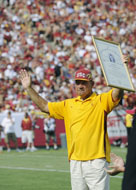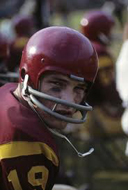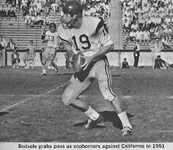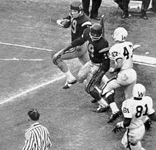| Hal Bedsole W'60 |

|
Hal Bedsole, one of the stars of the Trojans' 1962 national
championship team, was honored at a game this season. (Hans
Gutknecht/Staff Photographer).
With Hal Bedsole's journey
to New York tonight (Dec 3, 2012) for his induction into the
College Football Hall of Fame comes a full nostalgia tour.
It was 50 years ago today
when, as a USC junior wideout, he was honored at the same
Waldorf Astoria hotel as the youngest member of the College
Football All-American first team, the only underclassman
picked on the 11-man team that went both offense and defense
in those days. For this visit, Bedsole
will be the oldest of the group of 17 inductees, coming up
on age 71, for the College Hall's class of 2012 - the only
player representing the decade of the 1960s. "Maybe that kind of summarizes this whole thing," Bedsole said. "If I said, `Pick a guy from the '60s for the Hall, would you pick me?' That's what they did." |
|
The 1959 L.A. City Player of
the Year while playing quarterback at Reseda High, Bedsole
was a 6-foot-5, 220-pounder who spent a standout year at
L.A. Pierce College in 1960 before new USC coach John McKay
came calling.
Bedsole's conversion to a receiver couldn't have been more fortuitous. In three seasons as the go-to man for quarterbacks Pete Beathard and Bill Nelsen from 1961-63, "Prince Hal," as he was called, set a record that still stands at the school - the greatest average-per-catch for a career at 20.94 yards (with 30 or more receptions). His career marks of 82 catches for 1,717 yards and 20 touchdowns might not jump off the page by today's measurements, but in the context of the times, he's also remembered as a star of the 1962 national championship team and for catching two touchdowns in USC's win over Wisconsin in the '63 Rose Bowl to cap an undefeated season. Before leaving for New York, Bedsole, who 11 years ago was inducted into USC's athletic hall of fame, reflected on his honor and career from his Palm Desert home: Question: With your size and agility, how did you end up playing football at USC instead of maybe playing basketball at UCLA? Answer: My two sports were baseball and football, and in the L.A. City system, you couldn't play baseball and football at the same time. You had to make a choice of a sport each semester. Right before I left high school, some friends at Reseda talked me into trying the shot put on the track team - I did it strictly to be with my friends - and at the first meet I ended up breaking the school record. My grades weren't so great, so I went to Pierce, again to be with my friends, and did the discus, shot put and high jump. One of my favorite days was when we went to USC to compete against their freshman team, and I got to meet (legendary Trojans track athlete and then coach) Jess Mortensen. When I went to USC, the work load in school was so horrendous, there was no way I could do both football and track. In the offseason, all I could do was rest. Before I went to USC, I kind of burned my bridges at Notre Dame. They heavily recruited me out of high school, but they wanted me to go to the New Mexico Military Academy first, and I didn't want to do that. I was shocked I didn't get recruited by UCLA to play in their single-wing, because I was just a bigger, faster version of Billy Kilmer, who was running it then. I thought of myself as a running quarterback. USC had talked to me some when Don Clark was the head coach, but now John McKay was recruiting me after he took over. But I wasn't sure I was going to USC unless they offered a scholarship. Q: But with all the quarterbacks USC already had, why would you want to go there? You had to switch to receiver. How did that happen? A: It's a matter of who you believe. I've read John's book, so I know his version. I know that I went to McKay on the Tuesday of the first week before the season opener on Friday against Georgia Tech (in 1961). After practice, I said, `Is there any possibility I could play Friday?' He said, `Not at all,' because he wasn't going to get down to the third- and fourth-team players. I said, `What if I switch to a different position?' I know that sounded kind of naive, but I asked him anyway. `Well, what position?' If I went to receiver, I'd be on the third team. `But that would be up to you if you switch because you can't switch back (to quarterback),' McKay said. My only goal at USC was to get in the game. I know that sounds funny when you have guys today who get all kinds of guarantees and all. So I went to receiver and if it didn't work out, then I figured I'd move to the specialty defense - and this was a time when the NCAA required you to play both ways, to limit scholarships, and a team could make one substitution per quarter, so they'd sub in a whole new team on defense or offense. On the opening kickoff against Georgia Tech, Jim Bates, probably the fastest player on our team, broke his leg. He was the starting left split end. So right away, I was promoted to second team, unfortunately for Jim. Georgia Tech drove all the way with the opening kickoff, marched eight minutes, so we took the `red' team out with two minutes left to let them rest and put in the `yellow' team - so that got me in. I get thrown a pass and ran for about 20 yards. This looks pretty good. I ended up catching two or three balls that game. I'm not sure what McKay's opinion as of my performance, but two weeks later, against No. 1 Iowa on national TV, I was back to second team and was in the game in the second quarter and caught a 79-yard touchdown pass. Then I had another touchdown pass and a 2-point conversion. From then on I was a starter. McKay's story was that he came to me and said he wanted to switch me to receiver because I was too big to be a quarterback. I found out years later that he did it knowing he wasn't going to play me at quarterback, which I assume was true. I know we had Bill Nelson, who was a wonderful leader and good thrower, but not very good on defense. Pete Beathard was able to go both ways. It was clear to me that once he recognized who the best athletes were, they could get shuffled around, and that was McKay's way. It was all about building team speed. Q: Without that switch of positions, you likely wouldn't be in this position today of going into the College Football Hall of Fame, right? A: No question, and I might not have believed it at the time, but I'm sure this was all directed by a higher power. Your fate is what you're given, from one thing to another. Maybe if I went to Notre Dame, I'd have stayed a quarterback, I don't know. But I do know that the trait I had was: I always made big plays, on every level. Leading the City in scoring, leading Pierce in scoring, leading USC in scoring my first two years, and then (in the NFL) leading the Minnesota Vikings in scoring. Maybe that's why I'm in the Hall of Fame. You get remembered for the sum of what you've accomplished. I absolutely believe the best thing that happened to me was getting to go to USC, even if I didn't play quarterback. I'm forever grateful I went there and graduated. To me, it was a miracle at the time getting recruited by USC. Q: Why do you think it has taken all these years before the College Football Hall finally called? It's not as if your stats changed or anything. A: I've given a lot of thought to that in the last few months, and really, there's no explanation for it. It must be divine intervention. I'll tell you why. Hardly any voting member could say, `I remember watching him.' I think there's a window of comparability when they can look at the statistics. My window was a long time ago, before a lot of changes took place. I know my numbers are very modest. I'm not sure if many of the voters even know we were required to go both ways. I honestly think it's just another one of those blessings I've had my whole life. It's a mind-boggling thing, with all the candidates, the Heisman winners and Outland Trophy winners and Butkus winners, many who haven't got in (the Hall). Q: One stat that seems to still stand out - you're the first USC player to ever have a 200-yard receiving day (201 vs. Cal in 1962, a mark that stood for 21 years). What do you think of that accomplishment all these years later? A: I think that was earth-shattering at the time in college football. But I think the stat that still gets a lot of attention was the average per catch. I'm as proud of that as anything still being a USC record. I still see it published in every USC game program, so my grandkids can see it. I really didn't even know they kept that kind of statistic. Q: How did you take to having the nickname "Prince Hal"? A: I guess it was kind of embarrassing. It started when one writer, I think Mel Durslag of the L.A. Times, did some take off of Shakespeare and Henry VIII and somehow, the nickname `Prince Hal' was wove into the story. It all seemed silly to me. I didn't think it would last. But then, before I knew it, that's all I heard people call me on campus - just like `Jaguar Jon (Arnett).' It's an endearing way they say it. Nothing negative about it. It was funny earlier this season when I was being recognized on the field at a USC game for the College Hall of Fame. My grandkids heard people yelling `Hey, Prince!' at me. They were wondering who they were talking to. Finally, my granddaughter said, `Pops, what's Prince Hal?' I said, `I'll have to tell you later.' |
 |
 |
 |
 |
 |
| "Playboy's 1963 All-Star Team" with Hal in top right. |
 |
|
Top row, left to right: Ken Kortas, Tackle - Louisville; Jim Kelly, End - Notre Dame; Harrison Rosdahl, Tackle - Penn State; Hal Bedsole, End - Southern Cal. Middle Row, left to right: Jack Cvercko, Guard - Northwestern; Dick Butkus, Center - Illinois; Damon Barme, Guard - Southern Cal; Ara Parseghian, Coach of the Year - Northwestern. Bottom Row, left to right: Rick Leeson, Fullback - Pittsburgh; Marv Woodson, Halfback - Indiana; Tom Myers, Quarterback - Northwestern; Larry Dupree, Halfback - Florida. |

